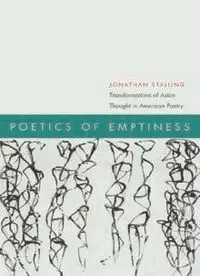
Poetics of emptiness: transformations of Asian thought in American poetry PDF
Preview Poetics of emptiness: transformations of Asian thought in American poetry
Poetics of Emptiness This page intentionally left blank Poetics of Emptiness Transformations of Asian Tought in American Poetry jonathan stalling Fordham University Press new york 2010 © 2010 Fordham University Press All rights reserved. No part of this publication may be reproduced, stored in a retrieval system, or transmitted in any form or by any means—electronic, me- chanical, photocopy, recording, or any other—except for brief quotations in printed reviews, without the prior permission of the publisher. Fordham University Press has no responsibility for the persistence or accuracy of URLs for external or third-party Internet websites referred to in this publi- cation and does not guarantee that any content on such websites is, or will re- main, accurate or appropriate. Library of Congress Cataloging-in-Publication Data Stalling, Jonathan. Poetics of emptiness : transformations of Asian thought in American poetry / Jonathan Stalling. — 1st ed. p. cm. Includes bibliographical references and index. ISBN 978-0-8232-3144-7 (cloth : alk. paper) 1. American poetry—Chinese infuences. 2. Emptiness (Philosophy) 3. Philosophy—East Asia. 4. Poetics. I. Title. PS159.C5S73 2010 811.009’384—dc22 2010005596 Printed in the United States of America 12 11 10 5 4 3 2 1 First edition A book in the American Literatures Initiative (ALI), a collaborative publishing project of NYU Press, Fordham University Press, Rutgers University Press, Temple University Press, and the University of Virginia Press. Te Initiative is supported by Te Andrew W. Mellon Foundation. For more information, please visit www.americanliteratures.org. For Amy Noél Stalling If we take an instantaneous photograph of the sea in motion, we may fx the momentary form of a wave, and call it a thing; yet it was only an incessant vibration of water. So other things, more things, apparently more stable, are only large vibrations of living substance; and when we trace them to their origin and decay, they are seen to be only parts of something else. And these essential processes of nature are not simple; there are waves upon waves, process below processes, systems within systems;—and apparently so on forever. —ernest fenollosa, “theory of literature” Contents List of Figures and Tables ix Acknowledgments xi Prologue: Transformations of a Transpacifc Imaginary 1 Introduction: Te Poetics of Emptiness, or a Cult of Nothingness 9 part one Buddhist Imaginaries 1 Emptiness in Flux: Te Buddhist Poetics of Ernest Fenollosa’s “Te Chinese Written Character as a Medium for Poetry” 33 2 Patterned Harmony: Buddhism, Sound, and Ernest Fenollosa’s Poetics of Correlative Cosmology 59 3 Teaching the Law: Gary Snyder’s Poetics of Emptiness 97 part two Daoist Imaginaries 4 Language of Emptiness: Wai-lim Yip’s Daoist Project 123 5 Pacing the Void: Teresa Hak Kyung Cha’s Dictée 157 Epilogue 191 Notes 199 Bibliography 235 Index 257 This page intentionally left blank Figures and Tables Figures P.1 Wai-lim Yip’s cross-cultural interpretation diagram 5 P.2 Zong-qi Cai’s cross-cultural interpretation diagram 7 2.1 Five-element diagram 71 2.2 Fenollosa’s notes on classical Chinese tonal prosody 74 2.3 Section of Fenollosa’s notes on classical Chinese tonal prosody 75 2.4 Tonal prosody chart 77 3.1 Tathāgatagarbha diagram 107 5.1 Image of Cha performing “A BLE W AIL” (1975) 158 5.2 Image of a Daoist cosmogonic chart, or 圖 (tu) 164 5.3 Chang Chung-Yuan translates taijitu as “chart of ultimatelessness” 166 5.4 “Étang,” by Teresa Hak Kyung Cha (1978) 169 5.5 Acupuncture points 172 5.6 Modern anatomical diagram of vocal organs 173 5.7 “Communication diagram” 185 5.8 “Trans(l)ative / Trans(l)iterative” diagram 188
